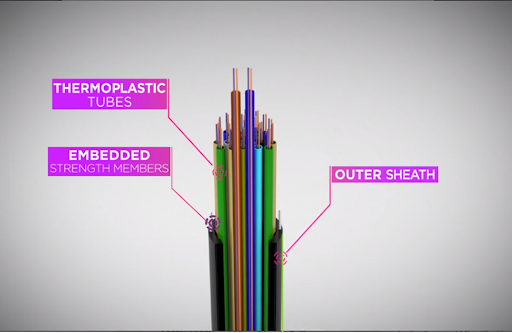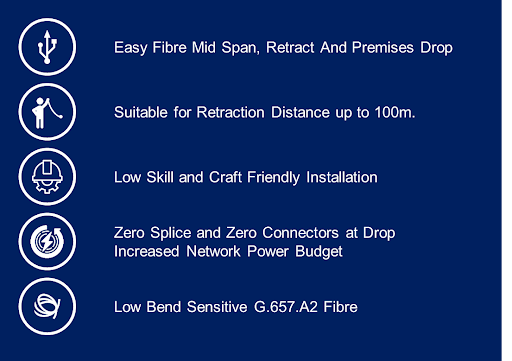We discuss the following topics in this blog:
- Increasing internet usage globally.
- Fibre to the home (FTTH) is the future of connectivity.
- Indicium Lite™ is an economically optimized option.
In addition to these topics, we shall also be answering the following FAQs:
- What is WiFi?
- What is an Optical Fibre Cable?
Contents
How has the Global Internet Traffic Skyrocketed Recently?
Over the last 2 decades, global data consumption has grown at an amazing rate. As per some estimates, global internet traffic has increased from 100 GB per day in 1992 to 46,600 GB per second in 2017. By 2022, it is expected to triple. In the same 5-year period, average broadband speed is expected to grow almost two-fold, from 39 Mbps to 75 Mbps.
This growth in internet traffic can be attributed to the increase in the number of connected devices per capita and usage of applications powered with high-speed internet like 4K television sets. COVID-19 pandemic has given us a sneak peek into the future, and it is evident that the bandwidth offered by various service providers, even in developed countries, falls short of customer expectations.
Way to the Future with Fibre to the Home (FTTH)
While deploying FTTH network, every network planner focuses on increasing 3 major factors, namely throughput, resilience, and reach. This is difficult to achieve with conventional FTTH cabling solutions, where 2-3 type of cables are required from Point of Presence (POP) to Optical Terminal Outlet (OTO). These solutions require a skilled technician, expensive fibre splicing machines, and other accessories for a standard FTTH roll-out. Also, due to the absence of provision for safe and secure storage of cable slack, excess fibre bending leads to unexpected increase in bend losses.
Indicium Lite™ Retractable Solution, For Faster FTTH Roll-Out
To make Fibre to the Home services available and affordable to everybody, operators need to adopt some innovative and sophisticated products, which ease the installation process. STL’s Indicium Lite ™ Retractable solution is one such product. It has up to 96 optical fibres bunched inside 24 Micromodule units, which can be deployed in two different types of deployment scenarios as mentioned below:
Multi-Dwelling Unit (MDU)
To provide an internet connection to geographical areas with flats and a large number of complexes, operators need to deploy high-count fibre cable, starting from Street Cabinet, which is deployed in ducts or overhead scenarios and gets terminated at the basement distribution box. From the distribution box, the drop cable goes to each floor and gets terminated at floor access terminals. Further, the drop cable can be extended from the floor access terminal to individual houses. With Indicium Lite, operators do not need to connect every home, and leverage the provision of extending the connection on a subscription basis.
Single- Dwelling Unit (SDU)
As STL’s Indicium Lite cable is optimized for outside plant application and is suitable for aerial to duct/underground transitions. To build network infrastructure in areas with a lot of houses spread across geography, operators need to connect this cable individually to each house. To connect any of the houses, operators are required to retrieve individual modules carrying 1 or 2 or 4 optical fibres from the cable and are terminated at the boundary box. Subsequently, they need to provide a tapping box outside each house. It helps connect various customer-premise equipment to this boundary box.

Indicium Lite™ Retractable Cable Structure

How Does Indicium Lite™ Save Costs?
Indicium Lite™ is an innovative optical fibre solution, which helps operators pass connectivity to homes at a much faster rate. The innovative design with Thermoplastic Tubes and Colour Coded Fibre units result in 20%-30% Faster Rollouts.
It is an economically optimized option, which helps reduce the expenses in multiple ways, and reduces the overall cost by 30-35%.
Due to ease of splicing, there is a huge cost saving by eliminating the need for expensive splicing tools and expenses incurred for highly skilled technicians.
The STL’s Indicium Lite™ Retractable Cable Solution is specially designed to be laid along with the FTTH network, passing fibres to the terminal points across Buildings, Dwellings and Houses. This allows the operator to develop a Fibre-ready Network infrastructure.
FAQs
What is WiFi?
Put simply, WiFi is a technology that uses radio waves to create a wireless network through which devices like mobile phones, computers, printers, etc., connect to the internet. A wireless router is needed to establish a WiFi hotspot that people in its vicinity may use to access internet services. You’re sure to have encountered such a WiFi hotspot in houses, offices, restaurants, etc.
To get a little more technical, WiFi works by enabling a Wireless Local Area Network or WLAN that allows devices connected to it to exchange signals with the internet via a router. The frequencies of these signals are either 2.4 GHz or 5 GHz bandwidths. These frequencies are much higher than those transmitted to or by radios, mobile phones, and televisions since WiFi signals need to carry significantly higher amounts of data. The networking standards are variants of 802.11, of which there are several (802.11a, 802.11b, 801.11g, etc.).
What is an Optical Fibre Cable?
An optical fibre cable is a cable type that has a few to hundreds of optical fibres bundled together within a protective plastic coating. They help carry digital data in the form of light pulses across large distances at faster speeds. For this, they need to be installed or deployed either underground or aerially. Standalone fibres cannot be buried or hanged so fibres are bunched together as cables for the transmission of data.
This is done to protect the fibre from stress, moisture, temperature changes and other externalities. There are three main components of a optical fibre cable, core (It carries the light and is made of pure silicon dioxide (SiO2) with dopants such as germania, phosphorous pentoxide, or alumina to raise the refractive index; Typical glass cores range from as small as 3.7um up to 200um), Cladding (Cladding surrounds the core and has a lower refractive index than the core, it is also made from the same material as the core; 1% refractive index difference is maintained between the core and cladding; Two commonly used diameters are 125µm and 140µm) and Coating (Protective layer that absorbs shocks, physical damage and moisture; The outside diameter of the coating is typically either 250µm or 500µm; Commonly used material for coatings are acrylate,Silicone, carbon, and polyimide).
An optical fibre cable is made up of the following components: Optical fibres – ranging from one to many. Buffer tubes (with different settings), for protection and cushioning of the fibre. Water protection in the tubes – wet or dry. A central strength member (CSM) is the backbone of all cables. Armoured tapes for stranding to bunch the buffer tubes and strength members together. Sheathing or final covering to provide further protection.
The five main reasons that make this technology innovation disruptive are fast communication speed, infinite bandwidth & capacity, low interference, high tensile strength and secure communication. The major use cases of optical fibre cables include internet connectivity, computer networking, surgery & dentistry, automotive industry, telephony, lighting & decorations, mechanical inspections, cable television, military applications and space.













